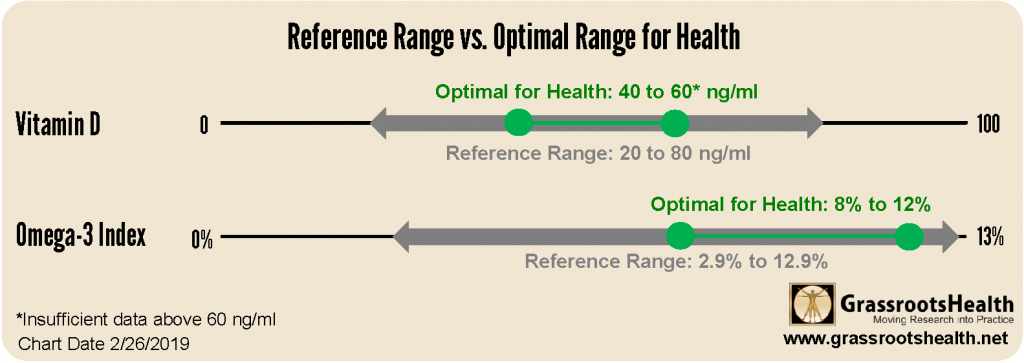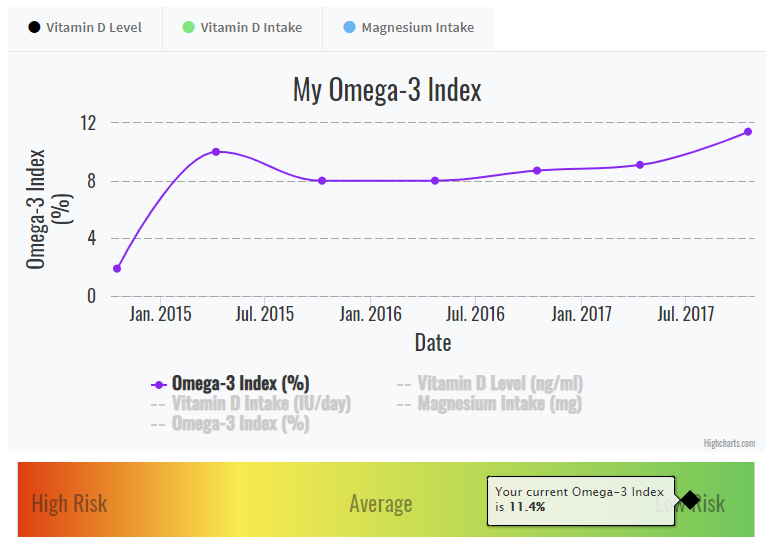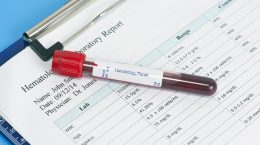Published on February 28, 2019
Does a laboratory reference range indicate the optimal range for health?
Lab test results often come with a set of numbers next to the result called a “reference range.” In this blog we will discuss what a reference range is and whether it indicates the optimal range for health.
What is a Reference Range?
 A reference range, sometimes called “normal values,” is a set of numbers representing the range of typical results. Each individual lab can establish their own reference range by calculating the range of values (after excluding the highest and lowest values) among a sample of “healthy” patients from within the population the lab serves. Since each lab can create its own reference range, these ranges can differ between labs and geographic regions. Differences in patient population, operating conditions, sample collection, criteria for “healthy” individuals, and environmental conditions can cause variation in reference ranges. Reference ranges can even change within an individual lab over time through re-assessment of their normal testing population.
A reference range, sometimes called “normal values,” is a set of numbers representing the range of typical results. Each individual lab can establish their own reference range by calculating the range of values (after excluding the highest and lowest values) among a sample of “healthy” patients from within the population the lab serves. Since each lab can create its own reference range, these ranges can differ between labs and geographic regions. Differences in patient population, operating conditions, sample collection, criteria for “healthy” individuals, and environmental conditions can cause variation in reference ranges. Reference ranges can even change within an individual lab over time through re-assessment of their normal testing population.
Labs can also use the reference range published by the manufacturer of a particular test method or the reference range from another local lab if they can verify that the published reference range represents the population the lab serves. For some lab tests, a consensus range or decision limit for treatment determined by a consensus group of medical experts is used instead of a reference range. For example, specific limits for cholesterol and glucose have been established to indicate when diagnosis and treatment are needed.
Does a reference range indicate the optimal range for health?
Simple answer: NO. A reference range indicates the range of typical results found in the population the lab serves but does not necessarily indicate the optimal range for health. For example, a lab’s reference range for vitamin D levels may be 20 to 80 ng/ml. While this is the range found in the lab’s testing population, this is NOT the range for optimal health. Our scientists’ consensus panel recommends achieving at least 40 ng/ml (100 nmol/L) up to 60 ng/ml (150 nmol/L) for optimal health. This is based on overwhelming evidence about the association between vitamin D and many diseases including bone diseases (rickets, osteomalacia, and osteoporosis), multiple sclerosis, diabetes, cancer, and many others.
Omega-3 and magnesium testing provides another example of the difference between the reference range and the optimal range for health.
The lab used by GrassrootsHealth for the omega-3 index has a reference range for omega-3 index of 2.9% to 12.9%. However, studies show that an omega-3 index of at least 8% is important for heart, brain, joint, and eye health. The lab’s reference range for the omega-6 to omega-3 ratio is approximately 1.5 to 7.3 and for the AA to EPA ratio is approximately 2.6 to 62.0. However, the desirable ranges for health are generally between 3 and 5 for the omega-6 to omega-3 ratio and between 2.5 and 11 for the AA to EPA ratio. Some experts recommend an even lower AA to EPA ratio (1 to 3) for the resolution of cellular inflammation. (Click here for more information on Omega-3 testing including what these ratios mean).
For red blood cell magnesium, the lab’s reference range is 2.8 – 4.6 mg/dL (28 – 46 mg/L) whereas several experts recommend a range of 6.0 to 6.5 mg/dL (60 – 65 mg/L) as optimal for health.

For many nutrients, we will now be working with many scientists to determine and achieve an expert consensus on the optimal range for health. By testing your nutrient levels and completing the health questionnaire, YOU are helping to achieve that goal for yourself and others.
How can I track my nutrient levels?
To help you track your nutrient levels, GrassrootsHealth has created an online tracking system called myData-myAnswers. This will help you know how your nutrient levels impact your health. Check it out today!








